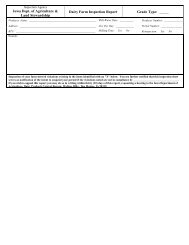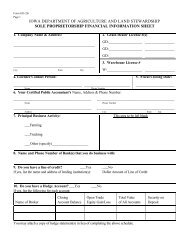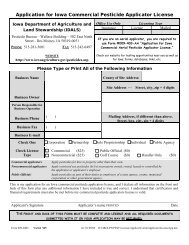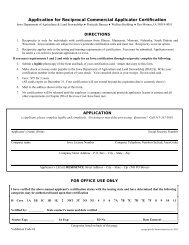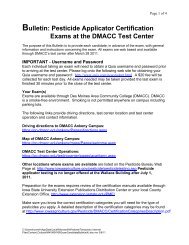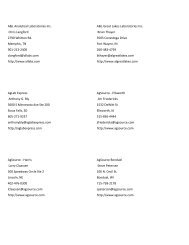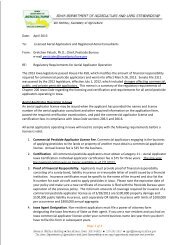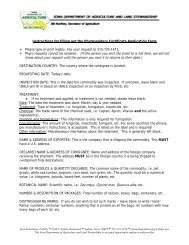Exhibit C: Detailed Background, Work Group Recommendations
Exhibit C: Detailed Background, Work Group Recommendations
Exhibit C: Detailed Background, Work Group Recommendations
Create successful ePaper yourself
Turn your PDF publications into a flip-book with our unique Google optimized e-Paper software.
Stakeholder approval/opposition<br />
OTHER OPINIONS EXPRESSED:<br />
Whenever possible, the workgroup tried to reach consensus on the statements and recommendations.<br />
When consensus was reached it was rarely unanimous. Below are the viewpoints of those that did not<br />
necessarily agree with the statements and recommendations above.<br />
♦ Government should not impose restrictions on the use of property. Many citizens that live in a<br />
flood plain are aware of and have accepted the risks and do not expect any help from the<br />
government.<br />
♦ Flood control structures are not reliable enough to be used extensively in flood plain<br />
management. Any flood plain management strategy that uses structural flood controls in lieu of<br />
removing or flood proofing structures in the 0.2% flood plain is incomplete and will fail eventually.<br />
Structural controls do have their place—to protect existing development that cannot be mitigated<br />
in other ways. However, in many instances, structural controls are used because they are less<br />
intrusive and less costly and more effective mitigation measures.<br />
♦ The geographic boundaries and the economic impacts of delineating the 0.2% flood plain area as<br />
the regulated flood plain are currently unknown. A mapping project has been recently initiated<br />
that will produce flood maps for the entire state but it will not be completed and approved by<br />
FEMA for another five to seven years. The delineation of the 0.2% flood plains and floodways<br />
should be completed in order to educate property owners and local communities and to make an<br />
informed policy decision. Some in the workgroup believe that the policy decision to move to a<br />
0.2% regulated flood plain should wait until delineation of the 0.2% flood plains and floodways is<br />
completed and the impacts of this change analyzed before making a policy decision which will<br />
have an impact on the property rights of many Iowans including the value of their property and<br />
risk of flood damage.<br />
The workgroup realizes that the expanded or new policy recommendations made here have serious<br />
implications to the citizens of Iowa. Many residences and other buildings will have to be moved from the<br />
0.2% flood plain after being damaged rather than being rebuilt in their current location. New<br />
development in the 0.2% flood plain, while not prohibited by these recommendations, will be more<br />
difficult and expensive than it is now. But the goal of these recommendations is to reduce the damage<br />
caused by flooding and that cannot be accomplished without changes in how we manage our flood<br />
plains.<br />
Many of the workgroup members are representatives of different public interest groups. While the<br />
representatives participated with the full knowledge of the groups they represent, it should not be<br />
assumed that the groups or their representatives fully endorse the recommendations or statements<br />
made herein.<br />
b. Resources considered<br />
i. Documents<br />
Floodway Diagram<br />
58


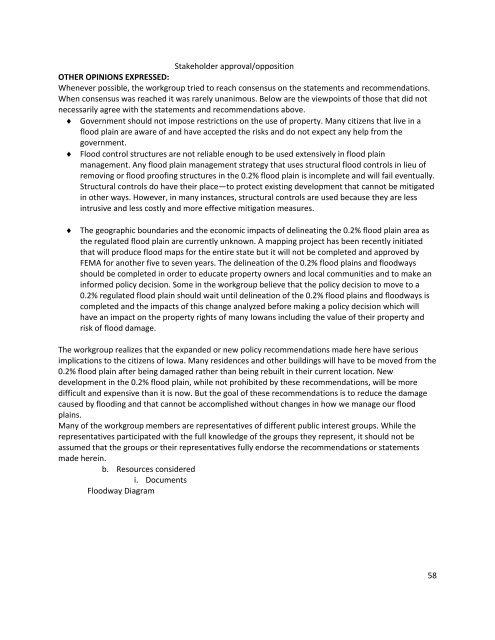
![Ch 44, p.1 Agriculture and Land Stewardship[21] IAC 4/23/08 - Iowa ...](https://img.yumpu.com/49992480/1/171x260/ch-44-p1-agriculture-and-land-stewardship21-iac-4-23-08-iowa-.jpg?quality=85)

